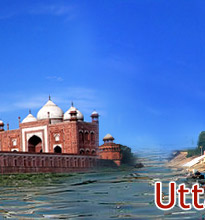 Saheth
is one of the most visited clusters of shrines in the Buddhist tourism
circuit of Eastern Uttar Pradesh. Saheth covers an area of around 35
square Kilometers and is located in the very heart of Sravasti. The site
falls on your right when you move nearly a kilometer Southwest from
Maheth.
Saheth
is one of the most visited clusters of shrines in the Buddhist tourism
circuit of Eastern Uttar Pradesh. Saheth covers an area of around 35
square Kilometers and is located in the very heart of Sravasti. The site
falls on your right when you move nearly a kilometer Southwest from
Maheth. The place has got generous mention in historical sources but has remained overlooked and abandoned for long. Emperor Ashoka once visited Sravasti. Even the famous Chinese pilgrim and traveler, Huien- Tsang, mentions two Ashoka pillars at Sravasti. The place forms an important angle in the Buddhist Triangle of Sarnath-Sravasti-Kushinagar in the eastern Uttar Pradesh. The place rose to prominence when excavation works revealed that Saheth was the original site of once magnanimous Jetavana monastery. The place saw sudden spurt in tourism after that discovery.
The place is full of numerous monasteries and shrines related to Buddhism apart from quite a few Stupas. Although most of these are in ruins, the place has a charm of its own. That is why; scores of visitors from all over the world visit this place. It has been reveled in excavation and post-excavation research works that the period of constructions of most of these shrines range from 3rd Century BC to 12th Century AD. Emperor Ashoka started the construction works that was continued by his successors. Kushana and Gupta rulers later carried it forward. It can be broadly classified that while most of the Stupas belong to the Kushana period, the temples are predominantly in the Gupta style. One of the earliest Stupas, probably dating to the 3rd century BC, contained relics of the Buddha. Nobody knows where these relics are. A colossal statue of the Buddha was also found here during the excavation that was surprisingly in healthy state. It was later transferred to Calcutta Museum in order to save it from being stolen.









